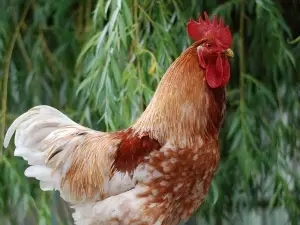
Chickens are low on the food chain, these birds know this and so do predators. This low position on the food chain makes chickens an easy and quick meal for predators of all types.
Your dog may attack your chicken as a means of getting food or because it simply enjoys the hunt, unfortunately, this can be very dangerous for your chicken.
If your chicken was attacked by a dog, and is in shock, this article looks into what to do
Table of Contents
Chicken attacked by a dog is in shock:
Shock can be dangerous to humans and to chickens, both humans and chickens can die of shock. If your chicken was attacked by a dog, and is in shock, this is what to do:
Isolate her:
The bird shouldn’t be in the coop, or around anything that can cause her stress, after the attack. Keep her stress levels down by keeping her inside in a quiet and dark space.
Keeping her isolated should relax her and help get her over her shock. It may take a few days for the bird to get over the attack so keep this in mind.
You may need to make an enclosure, with a heat lamp in it, for the bird. Use a soft material like a soft towel or pine shavings as flooring and place her inside.
Keeping the bird warm is also important. You can leave the heat lamp in her enclosure on to keep her warm.
Give the bird her own water and food while in the enclosure. If the bird is wounded, you’d need to follow the treatment instructions below and keep an eye out for any infections.
Reintroduce her to the flock after she goes back to normal
Try to perk her up:
Giving the bird sugar water will help perk her up.
If the bird isn’t drinking on her own you may need to syringe the sugar water into her mouth to get her to drink it. The bird doesn’t have to drink too much of this mixture, 10 full syringes of sugar water should be enough for her.
Offer electrolytes:
Electrolytes can be offered to the bird as well. These will help her get over the shock of the attack and will help her get over the shock of the injury.
Add the electrolytes to her drinking water. Do this for a maximum of 3 days. You can also give electrolytes to the bird through a syringe.
Treat the wound:
If the attack caused the bird to become injured then you’d need to quickly attend to the injury or else it may get infected.
Stop the bleeding:
If your bird was injured during the attack then you’d need to quickly stop the bleeding.
Use a gauze, a clean towel, or a paper towel and press it against the open wound. Apply firm but gentle pressure onto the wound to stop the bleeding.
You can also apply an anti-coagulant powder onto the wound to help stop the bleeding
Tend to the wound/s:
You’d need to examine the bird from head to toe looking for any more injuries.
Some of the bird’s wounds may be concealed by feathers. Bathing the bird is recommended as this may help you see the wounds easier between the feathers.
You can use a saline solution on the wound to clean it up.
You can alternatively use a solution made up of betadine diluted in a saline solution to clean the wound. The betadine and saline solution should be the color of weak black tea.
You can also use chlorhexidine 2% solution spray on the wound to clean it up
Trimming the feathers around the wound may help you see the wound better and help with the healing
Keep an eye on the wound while the bird is in isolation, make sure that the wound is healing and is not becoming infected.
When to take her to the vet:
If the bird seems to be getting better, and goes back to acting normally, then the bird is recovering.
But, if the bird is still acting abnormally, if the bird is weak, is acting clumsy, is not eating or drinking, and is showing odd behavior, then you’d need to quickly get her to the vet.
The vet will examine her checking for internal and external injuries, the vet will also do an X-ray on the bird to check that her bones are unaffected.
If you enjoyed this article then you may also be interested in other chicken related articles. Here are some articles that you may be interested in: Open Wound On Chickens Neck, Chickens Wound Smells, Vetrx For Scaly Leg Mites, Dislocated Hock Joint Chicken, Baby Chick Is Limping, Black Spots On Chicken Legs

